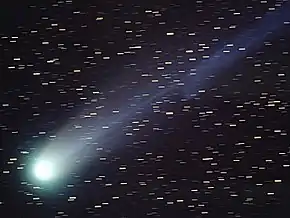P/2016 G1
P/2016 G1 (PANSTARRS) was an asteroid that astronomers believe disintegrated in 2016.[1]
When observed, on April 1, 2016, discoverers Robert Weryk and Richard Wainscoat thought the object was an Encke-type comet,[2] and the object was subsequently designated P/2016 G1.[3] After further analysis what had initially appeared to be a comet's halo turned out to be rubble from a collision. By November, 2019, analysis suggested the collision had occurred on March 6, 2016, and the asteroid was struck by a smaller object that may have massed only 1 kilogram (2.2 lb), and was traveling at 11,000 miles per hour (18,000 km/h).[1] P/2016 G1's diameter was between 200 metres (660 ft) and 400 metres (1,300 ft).[4]
Earlier images were found of an intact asteroid in 2015.[5] The asteroid had completely disintegrated by 2017.[4]
Astronomers were able to use the asteroid's rubble to determine the date of the collision, since the dispersion of dust was inversely proportionals to its size.[4]
References
-
Robin George Andrews (November 26, 2019). "This Is What It Looks Like When an Asteroid Gets Destroyed". The New York Times. Retrieved November 30, 2019.
Astronomers first discovered P/2016 G1 with the Pan-Starrs1 telescope in Hawaii in April 2016. Backtracking through archived images, astronomers realized that it had first been visible the previous month as a centralized collection of rocky clumps: the fractured, rubbly remnants of the asteroid, surrounded by a fine dust cloud, most likely the immediate debris jettisoned by the impact.
-
F. Moreno; J. Licandro; A. Cabrera-Lavers; F.J. Pozuelos (2016). "Early evolution of disrupted asteroid P/2016 G1 (PANSTARRS)". The Astrophysical Journal Letters. 826 (2): L22. arXiv:1607.03375. Bibcode:2016ApJ...826L..22M. doi:10.3847/2041-8205/826/2/L22.
P/2016 G1 (PANSTARRS) (hereafter P/2016 G1 for short) was discovered by R. Weryk and R. J. Wainscoat on CCD images acquired on 2016 April 1 UT with the 1.8-m PanSTARRS1 telescope (Weryk & Wainscoat 2016).
- "JPL Small-Body Database Browser: P/2016 G1 (PANSTARRS)" (2016-08-09 last obs.). Jet Propulsion Laboratory. Retrieved January 8, 2020.
-
Nola Taylor Redd (November 20, 2019). "Deadly Collision Blows an Asteroid Apart". Eos Science News by AGU. Retrieved November 30, 2019.
By 2017, P/2016 G1 was completely gone, most likely blown apart by the collision.
-
Olivier R. Hainaut; Jan T. Kleyna; Karen J. Meech; Mark Boslough; Marco Micheli; Richard Wainscoat; Marielle Dela Cruz; Jacqueline V. Keane; Devendra K. Sahu; Bhuwan C. Bhatt (July 2, 2019). "Disintegration of Active Asteroid P/2016 G1 (PANSTARRS)". Astronomy & Astrophysics. arXiv:1907.00751.
The position of P/2016 G1 was imaged 12 additional times in the PS1 data prior to discovery, between 2011 Feb. 23 and 2015 Jan. 17 and nothing was visible down to the limiting magnitudes shown in Table .1.
External links
- P/2016 G1 (PANSTARRS), Minor Planet Center
- Images of P/2016 G1, Luc Arnold


